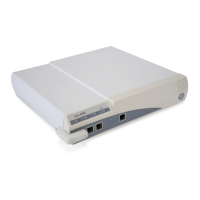4-30 Solar 8000M/i patient monitor 2026265-075C
Maintenance and checkout: Checkout procedure
The pump shuts off at about 250 mmHg, and the pressure drops
slowly to about 240 mmHg before stabilizing. The second line of text
on the CAL GAIN menu item changes from INFLATING to
HOLDING
NOTE
If the pressure continues to drop at a rate of 1 mmHg or more for
every five seconds, there is a leak in the NBP plumbing. If there is a
leak in the NBP plumbing, correct the problem and restart this
calibration procedure.
10. Select ENTER CAL PRESSURE.
11. An ENTER CAL PRESSURE popup window appears. Use the Trim
Knob control to select a pressure value that is 1 mmHg lower than
the current manometer reading.
12. When the manometer falls to exactly the value that you selected in
the popup window, press the Trim Knob control to enter the value.
Select PREVIOUS MENU to return to the MAIN MENU button.
13. Select CHECK CAL OFF.
14. Select START.
15. The text on the menu item changes from CHECK CAL OFF to
CHECK CAL IN PROGRESS. Make sure that the pressure
readings (shown as CUFF in the NBP parameter box) on the monitor
display and manometer are equal (± 1 mmHg) for at least one full
minute.
16. Select CHECK CAL IN PROGRESS.
17. Select STOP. The module then releases pressure in the bulb or cuff.
18. Remove the cuff and manometer from the acquisition device.
Defib/sync and analog output test
Patient Data Module
1. Connect the unterminated cable assembly to the Defib/Sync
connector on the front of the Patient Data Module.
2. Set up the simulator:
Heart rate = 80 bpm
Amplitude to 1.0 mV
3. Test the ECG, Arterial BP, and Marker Out signals from the DEFIB
SYNC connector using an oscilloscope to connect to the appropriate
wire on the test cable (shown below). They should resemble the
waveforms in the following figures. Note that there are two Marker
Out traces shown. The top trace shows the frequency of the pulses;
the bottom trace shows the pulse width.

